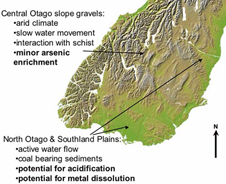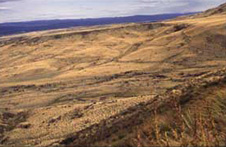 1: Potential concerns for groundwater quality in the lower South Island
1: Potential concerns for groundwater quality in the lower South Island  2: Margin of Dunstan Range, central Otago, with broad alluvial fans made of schist gravel. Slow-moving groundwater in this arid environment can potentially leach arsenic from the gravel.
2: Margin of Dunstan Range, central Otago, with broad alluvial fans made of schist gravel. Slow-moving groundwater in this arid environment can potentially leach arsenic from the gravel.
Groundwater is extracted from young sediments in basins, valleys, and coastal plains throughout New Zealand.
- Most groundwater is of high quality and is readily replaced by rain and river recharge.
- Some groundwater resources are being extracted at the limits of sustainability, and deeper resources are being tapped.
- Deeper waters move more slowly, are older, and can interact with more with rocks, and have potential for containing elevated metal contents.
- Groundwater from coal-bearing sediments also has the potential to become acidified with enhanced metal dissolving properties (e.g., Southland, North Otago; see map to right).
Arsenic in groundwater: the Bangladesh analogy
- Groundwater in many areas of Bangladesh has elevated arsenic concentrations, leading to what has been called the largest case of mass poisoning in human history.
- Key geological features which have contributed to high arsenic in Bangladesh are:
- Water is in young sediments derived from active mountains.
- The sediments contain only background arsenic concentrations.
- Because the sediments were transported and deposited rapidly, they still contain minerals which are susceptible to chemical interaction with groundwater.
- This groundwater interaction can dissolve arsenic at low levels.
- Water levels in sediments fluctuate in seasonal wet/dry climate.
- This water level fluctuation can induce chemical processes which concentrate the arsenic.
- Many of these geological features apply for New Zealand groundwater (map above).
- Generally, groundwater sources tapped in New Zealand have sufficient water movement to ensure that any dissolved arsenic is diluted to low levels.
- Some slope gravels in Central Otago have all of the above characteristics, and arsenic levels are slightly elevated locally (marginally above drinking water limits).
- Arsenic in groundwater in Otago Schist
Related
Introduction
Overview: Geological setting for Metals in the New Zealand environment
- Epithermal Gold
- Mesothermal Gold
- Acid Rock drainage
- Coal
- Metals in groundwater
- Alluvial Gold
- Northland Mercury
-
Hot Springs (in heavy metals)
